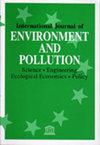On the comparison of urban canopy effects parameterisation
IF 0.3
4区 环境科学与生态学
Q4 ENVIRONMENTAL SCIENCES
International Journal of Environment and Pollution
Pub Date : 2019-08-22
DOI:10.1504/IJEP.2019.10023405
引用次数: 8
Abstract
To assess the impact of cities on climate, modelling is used with inclusion of urban parameterisation which is important when applying higher resolution. It is essential to assess uncertainties of urban effect parameterisations. To estimate this we performed experiments with available settings of urban canopy models over central Europe for 2001-2010. We have used RegCM4 and WRF in 10 km resolution, three surface schemes and five urban canopy parameterisations available. Selected WRF options were tested for urbanised weather prediction in 3 km resolution to show the effect in a single extreme case study. Urban heat island was detected in all simulations, for summer night the strongest on average was a few °C. We demonstrate that for cities like Prague it can in extremes approach 5°C, for larger city such as Budapest it is 8°C. In weather prediction mode, WRF model captured these effects in a single heat wave with selected parameterisations well.城市冠层效应参数化比较研究
为了评估城市对气候的影响,使用了包含城市参数化的模型,这在应用更高分辨率时很重要。评估城市效应参数化的不确定性至关重要。为了估计这一点,我们利用2001-2010年中欧城市冠层模型的现有设置进行了实验。我们使用了RegCM4和WRF的10公里分辨率,三种地表方案和五种城市冠层参数化。选定的WRF方案在3公里分辨率的城市天气预报中进行了测试,以显示在单个极端案例研究中的效果。在所有模拟中都检测到城市热岛,夏季夜间平均最强为几°C。我们证明,像布拉格这样的城市在极端情况下可以接近5°C,像布达佩斯这样的大城市可以达到8°C。在天气预报模式中,WRF模式通过选定的参数化很好地捕获了单个热浪的这些影响。
本文章由计算机程序翻译,如有差异,请以英文原文为准。
求助全文
约1分钟内获得全文
求助全文
来源期刊
CiteScore
1.10
自引率
0.00%
发文量
3
审稿时长
4.5 months
期刊介绍:
IJEP provides an international forum in the field of environment and pollution and addresses early and medium-term challenges involving scientific prediction, modelling and assessment. It focuses on ground-breaking research in the science of environmental pollution, at the early scientific stage. It is one of three key journals which together offer complete coverage of environmental issues: IJETM focuses on technical/engineering, policy and management solutions for environmental problems, and IJGEnvI focuses on future, longer-term environmental scenarios, ecological economics, climate change and biodiversity.

 求助内容:
求助内容: 应助结果提醒方式:
应助结果提醒方式:


